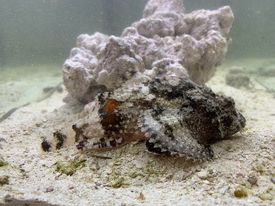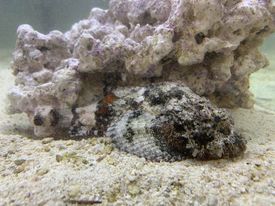 My son and I have been spoiled in recent weeks with opportunities to dive on some amazing shipwrecks off the coast of North Carolina. We’ve been blessed with near ideal conditions and massive aggregations of sharks, making for some of the most exciting underwater experiences of my life. So, when I asked him this week if he wanted to do a shore dive with me at Radio Island, a small sandy island nestled between the ports of Morehead City and Beaufort, I wasn’t sure if he’d be on board.
My son and I have been spoiled in recent weeks with opportunities to dive on some amazing shipwrecks off the coast of North Carolina. We’ve been blessed with near ideal conditions and massive aggregations of sharks, making for some of the most exciting underwater experiences of my life. So, when I asked him this week if he wanted to do a shore dive with me at Radio Island, a small sandy island nestled between the ports of Morehead City and Beaufort, I wasn’t sure if he’d be on board.
 The current there is impossible to fight, except for a brief window when the tide slacks. And all that tidal current stirs up a lot of sediment, making for poor visibility. Add to that the overcrowded beach where we access the water and the noise and turbulence from all the boat traffic, and you get what most people would consider less-than-perfect dive conditions. Surprisingly, he gave me an enthusiastic “yes” and after overheating in the August sun waiting for the tide to slack, and struggling to stay together in the murky water, he emerged 58 minutes later, just as animated and impressed as he was after our dive on the Caribsea wreck last week!
The current there is impossible to fight, except for a brief window when the tide slacks. And all that tidal current stirs up a lot of sediment, making for poor visibility. Add to that the overcrowded beach where we access the water and the noise and turbulence from all the boat traffic, and you get what most people would consider less-than-perfect dive conditions. Surprisingly, he gave me an enthusiastic “yes” and after overheating in the August sun waiting for the tide to slack, and struggling to stay together in the murky water, he emerged 58 minutes later, just as animated and impressed as he was after our dive on the Caribsea wreck last week!
 It didn’t hurt that we were suddenly surrounded by young kids asking him questions and eagerly accepting the sand dollar shells we had picked up for them along the way. The dive is documented in Finn’s latest video (below). In it he references our spearfishing activities. Spearfishing is our favorite type of fishing because it doesn’t involve bloodying up a lot of fish that we have no intention of keeping and eating, and it doesn’t contribute to the wasteland of fishing line and other gear that we encounter on every dive. If you watch very closely, you can spot two scorpionfish (Scorpaena plumieri) in Finn’s video. Interestingly, we only saw and intentionally recorded one of them on the dive. We didn’t notice the other one until after reviewing the video.
It didn’t hurt that we were suddenly surrounded by young kids asking him questions and eagerly accepting the sand dollar shells we had picked up for them along the way. The dive is documented in Finn’s latest video (below). In it he references our spearfishing activities. Spearfishing is our favorite type of fishing because it doesn’t involve bloodying up a lot of fish that we have no intention of keeping and eating, and it doesn’t contribute to the wasteland of fishing line and other gear that we encounter on every dive. If you watch very closely, you can spot two scorpionfish (Scorpaena plumieri) in Finn’s video. Interestingly, we only saw and intentionally recorded one of them on the dive. We didn’t notice the other one until after reviewing the video.
Here is a complete list of all the fish species we encountered on this dive:
Fish List from Radio Island, NC 08/08/2023
Inshore lizardfish (Synodus foetens)
Oyster toadfish (Opsanus tau)
Spotted scorpionfish (Scorpaena plumieri)
Leopard searobin (Prionotus scitulus)
Blue runner (Caranx crysos)
Yellow jack (Caranx bartholomaei)
Gag grouper (Mycteroperca microlepis)
Belted sandfish (Serranus subligarius)
Sand perch (Diplectrum formosum)
Black seabass (Centropristis striata)
Pinfish (Lagodon rhomboides)
Spottail pinfish (Diplodus holbrookii)
Sheepshead (Archosargus probatocephalus)
Longspine porgy (Stenotomus caprinus)
Atlantic spadefish (Chaetodipterus faber)
Slippery dick (Halichoeres bivittatus)
Southern flounder (Paralichthys lethostigma)
Planehead filefish (Stephanolepis hispidus)
Bandtail puffer (Sphoeroides spengleri)
Northern puffer (Sphoeroides maculatus)
Striped burrfish (Chilomycterus schoepfi)
Assorted sardines, anchovies, and silversides








Great footage and I enjoyed your dissertation on Radio Island. Randy in Pittsburgh ( a marine biologist who moved inland for a cool job and two be with a woman whop became my wife. We had two children and they got their scuba certification and I took them down to the Florida Keys to get them acquainted with the ocean. Your video brings back many memories so I thank you.)